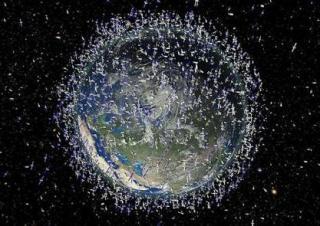
MELBOURNE (PTI): Australian scientists will use lasers to track and zap dangerous space junk, in an effort to prevent a real-life version of the space disaster portrayed in the Oscar-winning movie 'Gravity'.
The Australian Government's Industry Department has announced a new USD 20 million Cooperative Research Centre (CRC) to help scientists find and track tiny pieces of debris orbiting the Earth.
Space debris poses serious risk of collision with satellites, space stations and other space craft, similar to the events portrayed in the movie 'Gravity'.
"There are hundreds of thousands of pieces of space junk in orbit that are big enough to do serious damage to a satellite or space station," said Professor Matthew Colless, Director of the Australian National University Research School of Astronomy and Astrophysics at Mount Stromlo, on the outskirts of Canberra.
"We now want to clean up space to avoid the growing risks of collisions and to make sure we don't have the kind of event portrayed in Gravity," Colless said.
In the movie 'Gravity', which won seven Oscars at this year's Academy Awards, Dr Ryan Stone (Sandra Bullock) a medical engineer and astronaut Matt Kowalsky (George Clooney), are stranded in space after high-speed debris collides with their spacecraft.
Colless said space junk ranged from tiny screws and bolts, to larger parts of old rockets, mostly moving in low orbits around the Earth.
He said the new CRC would use lasers to find and track the space junk so satellites and space craft could avoid a collision.
He said the ultimate goal would be to zap the debris with lasers, slowing their orbits and allowing the space junk to fall back into the atmosphere, where it would burn up harmlessly.
"Without efforts to clean up the space junk, it could eventually become impossible to send satellites into space," he said.
CRC Chief Executive Dr Ben Greene said scientists estimate more than 300,000 pieces of space junk are in orbit, posing serious risks to satellites and space exploration.
"There is now so much debris that it is colliding with itself, making an already big problem even bigger. A catastrophic avalanche of collisions that would quickly destroy all satellites is now possible," Greene said.
"Our initial aim is to reduce the rate of debris proliferation due to new collisions, and then to remove debris by using ground-based lasers," he said.
 Previous Article
Previous Article Next Article
Next Article












The Indian Air Force, in its flight trials evaluation report submitted before the Defence Ministry l..
view articleAn insight into the Medium Multi-Role Combat Aircraft competition...
view articleSky enthusiasts can now spot the International Space Station (ISS) commanded by Indian-American astr..
view article